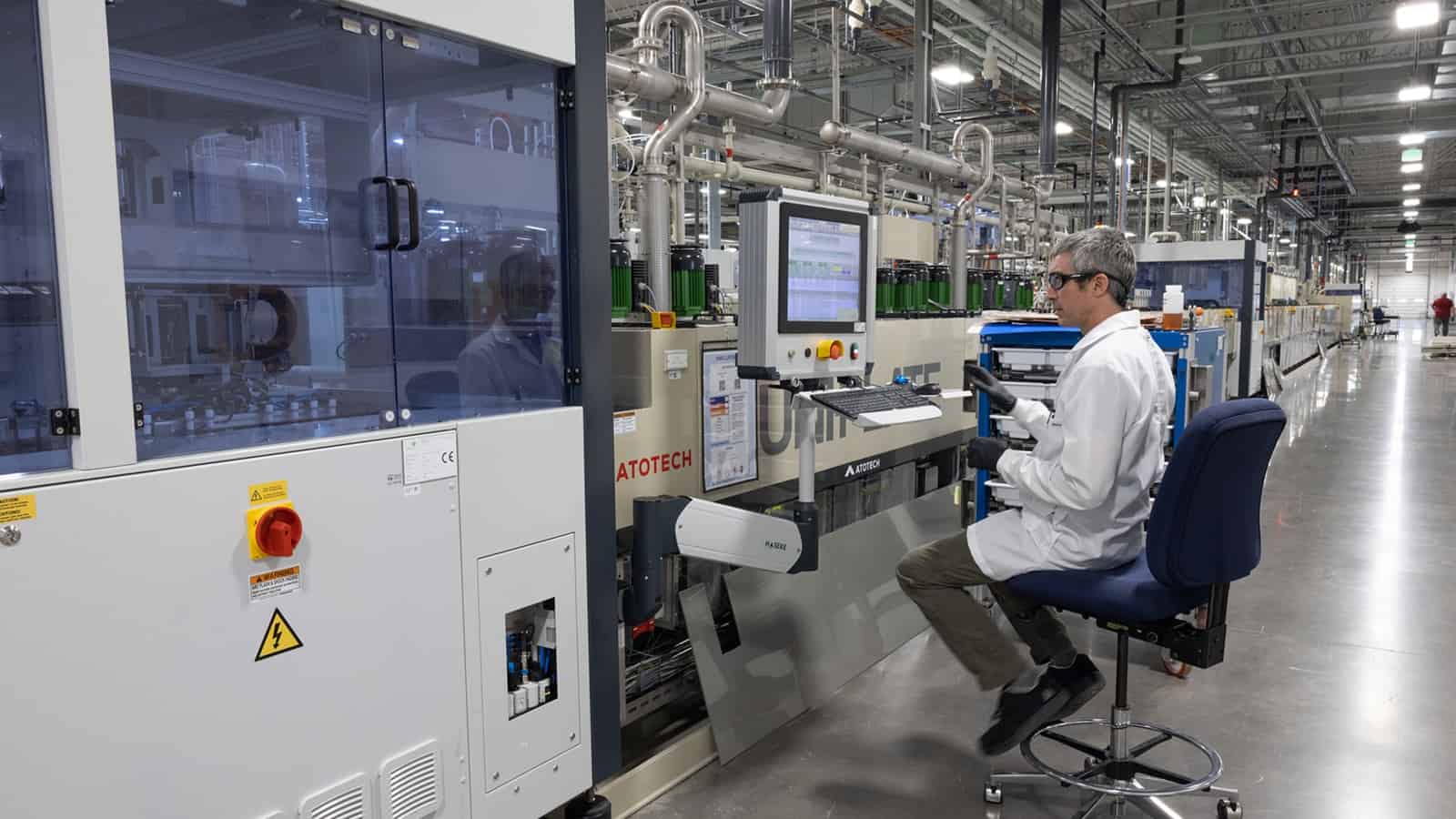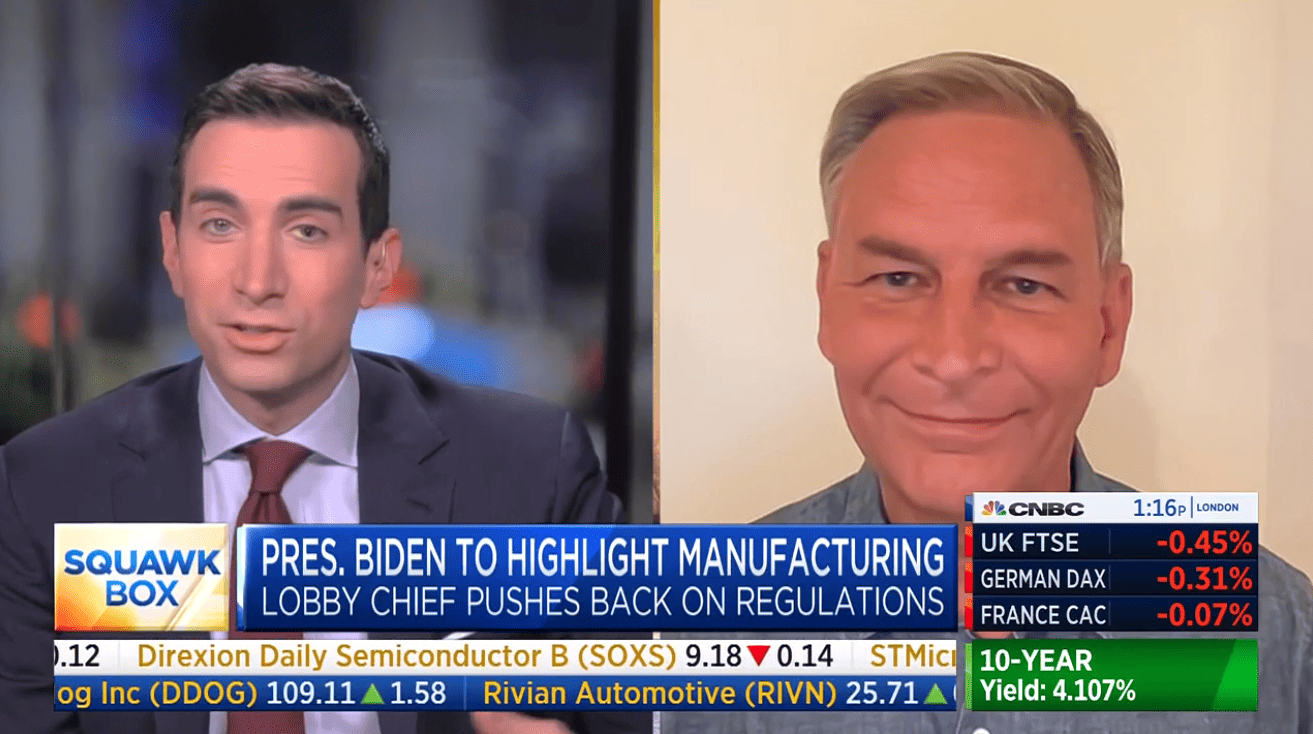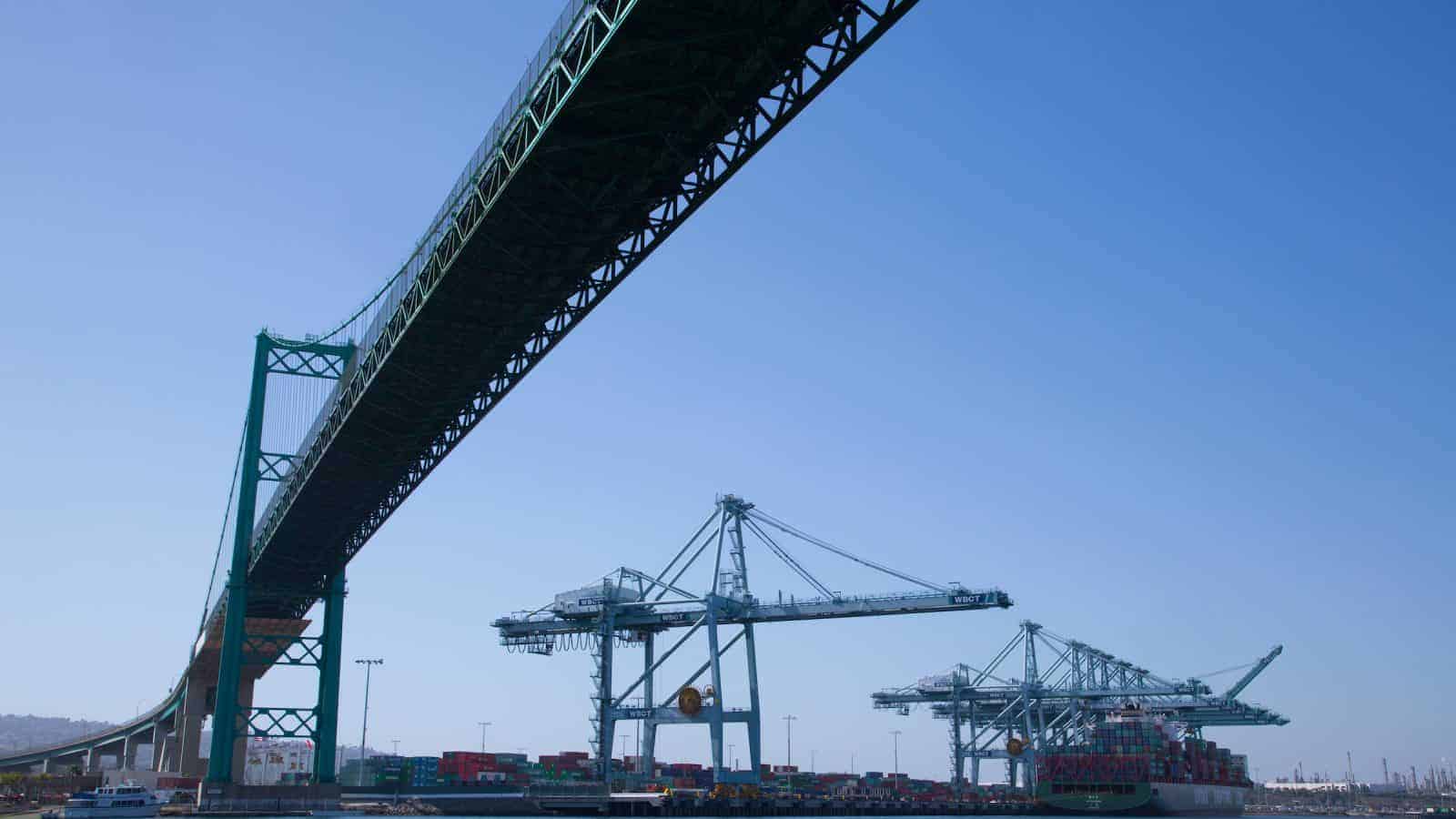A Homegrown Solution: Schweitzer Engineering Laboratories Makes Printed Circuit Boards

With one of its key components—printed circuit boards—in short supply, Schweitzer Engineering Laboratories chose the proactive solution: it would begin making them itself. Now that its new factory is up and running, SEL is receiving unexpectedly keen interest from other companies, and considering ramping up production for outside sales.
Fixing a supply chain problem: The Pullman, Washington–based electric power system protection solution manufacturer began manufacturing PCBs at its new $100 million, 162,000-square-foot factory in Moscow, Idaho, back in March.
- “Printed circuit boards take electronic components and interconnect them so they can interact with each other,” SEL CEO David Whitehead said. “Without them, you can forget about AI, forget about your cell phones—they’re in just about any electronic device.”
- The Moscow factory is running at about 25% capacity. When it reaches full production later this year, it will be one of the top PCB manufacturers in the U.S., according to Whitehead.
Domestic and accessible: The PCB “is a critical component that goes into our devices,” Whitehead continued. “Now, instead of sourcing PCBs from around the U.S., we can produce them ourselves.”
- The Moscow facility—which only produces the circuit boards for SEL—has increased the company’s supply chain resiliency and sped up its output, Whitehead told us. “Now, in a handful of days after designing a printed circuit board for a product, our engineers are in their labs testing it. It’s a big win for us.”
- Nearly half of manufacturers in the U.S.—44.9%—cite supply chain hurdles as one of their top business challenges, according to the NAM’s Q2 2023 Manufacturers’ Outlook Survey.
Self-funded and viable: SEL funded 100% of the facility’s construction costs, and it will have paid for itself in two to three years, Whitehead said.
- “I think that’s really a big deal for not only taxpayers but the local community generally,” he said. State and local governments “can take the funds [they didn’t use on us] and invest” elsewhere.
A good neighbor: The Moscow plant—which features a fume scrubber system that exceeds Environmental Protection Agency standards for volatile organic compounds—also uses a “zero-liquid discharge water treatment system that recycles and reuses all the water used to manufacture the printed circuit boards,” Whitehead said.
- A comparable factory would use about 90,000 gallons of water each day of production, while SEL uses about 500 to 600 gallons—the equivalent of only a few households’ daily usage, according to Whitehead. Most of that is for worker needs (drinking water and restrooms).
- The company also reclaims and reuses metals, such as tin, silver and gold, that are used in the production process.
- “We are very environmentally conscious about how we produce these boards,” Whitehead said.
What’s next? Since the facility began production, SEL has gotten numerous inquiries from other manufacturers interested in buying the PCBs. The company is likely to oblige them soon.
- “This is our next opportunity,” Whitehead said of producing boards for other manufacturers. “We love being vertically integrated, building as much as we can close to where we’re going to use the products. … As we get better at it for our own consumption, I can see us expanding it.”
DOE to Announce Carbon-Removal Project Winners

The Biden administration will soon announce the first grant winners of a multi-billion-dollar competition to speed up development of technology to “remove carbon dioxide from the sky,” according to E&E News’ CLIMATEWIRE (subscription).
What’s going on: The “awards for so-called direct air capture hubs could define the future of the nascent DAC industry in the United States as well as the broader CO2 removal sector, experts say.”
- The Department of Energy received more than a dozen proposals in response to the $3.5 billion DAC hub competition, which was created in 2021 as part of the historic bipartisan infrastructure legislation and seeks to increase the use of DAC technology.
- The projects expected to be announced this month could get “between $3 million and $500 million in matching funds” for efforts such as DAC undertakings capable of capturing and storing one million tons of carbon dioxide every year.
What it is: DAC plants use filters, power, piping and fans to remove carbon dioxide from the air and sequester it underground.
- Just 27 such facilities have been commissioned globally, and the largest of these can remove 4,000 tons of carbon dioxide from the atmosphere annually.
The economic challenge: “At the moment, it costs around $700 per ton for a DAC facility to remove carbon from the air, according to the industry data clearinghouse CDR. The Inflation Reduction Act, meanwhile, increased the tax incentives for DAC operators to $180 per ton for the CO2 they permanently store.”
- To bridge that cost gap, last year Congress ordered the Biden administration to start a pilot program to pay DAC firms and developers of carbon-removal technology to remove emissions from the air.
The final say: “Manufacturers view clean energy solutions—such as carbon capture and sequestration/storage technologies and hydrogen—as important parts of our country’s energy present and future,” said NAM Director of Domestic Economic Policy Brandon Farris.
- “Manufacturers are leading the charge in developing them and scaling them up for widespread use.”
Timmons on Regulations: Make Them “Sensible and Achievable”

“There are good things coming from [the Biden] administration”—including the CHIPS and Science Act and historic infrastructure investment—but there are also several trends that spell trouble for manufacturing in the U.S., NAM President and CEO Jay Timmons said on CNBC’s “Squawk Box” on Monday.
A three-fold issue: “On the one hand we have a manufacturing strategy that Congress and the administration have been putting forward, which is … to prioritize growing manufacturing here in the United States,” Timmons told CNBC’s Andrew Ross Sorkin.
- “But … you’re compounding that with three things. One is the [number] of regulations coming down. … [Two is] slow permitting, which is making it difficult for manufacturers to build those facilities they’re willing to invest in. Thirdly, [in] some of the provisions that have been enacted, there’s been confusing guidance or no guidance when it comes to accessing the funds and credits that are available for manufacturing. All three of those things together are making it very difficult for manufacturers to compete and succeed in our global economy.”
- The NAM is engaging on approximately 100 different regulations coming from 30 different government agencies, Timmons added.
Make regulation smart, achievable: Manufacturers are in favor of reasonable regulations that enable them to succeed, Timmons continued. “We’re not saying ‘No regulation’; we’ve never said that. What we’re saying is, ‘Let’s make these regulations essential, smart and achievable.’”
- He cited the National Highway Traffic Safety Administration’s new Corporate Average Fuel Economy Standards—which the NAM has told the administration are unworkably stringent and will drive up costs for manufacturers—as well as the Environmental Protection Agency’s new standards for ambient air quality, which a NAM-commissioned study found would threaten billions in economic activity and cost hundreds of thousands of jobs.
NAM in action: The NAM recently joined forces with members of its Council of Manufacturing Associations and the Conference of State Manufacturing Associations to launch Manufacturers for Sensible Regulations, a coalition created to address the negative effects of these federal regulations.
Canadian Dockworkers, Employer Reach Deal

Canadian dockworkers and their employers in British Columbia agreed to a labor contract Sunday, ending the uncertainty that has plagued the North American port system for the past month, according to CNBC.
What’s going on: The International Longshore and Warehouse Union of Canada voted to ratify a four-year agreement with the British Columbia Maritime Employers Association following a tumultuous few weeks that included two dockworker strikes—one lasting 14 days and the other only a day.
- “The new deal includes increases in wages, benefits, and training,” according to BCMEA, which also said deal ratification would offer “certainty and stability for the future of Canada’s West Coast ports.”
Why it’s important: During the two-week strike, “[s]ome U.S. shippers reconsigned the destination of their containers to the U.S during that time. Other ocean carriers eventually went back to the Canadian ports and waited to unload both Canadian and U.S. freight.”
- Changes to shipping routes affect railroads, since fewer containers traveling by rail can be unloaded at ports during work disruptions.
- It could take the railroads weeks to clear the backlog of containers built up as a result of the work stoppage.
- While train trade from Canada to the U.S. is recovering, it still ended the week of July 29 with a 6.2% decrease, according to CNBC.
The NAM’s take: “Disruptions to the interconnected North American supply chain have been a constant challenge for manufacturers over the past several years,” said NAM Director of Infrastructure and Labor Policy. “We welcome the announcement that this agreement has been ratified and will continue urging swift resolution to labor negotiations that might further impede reliable and efficient freight movement.”
Utilities Scramble to Get Large Transformers

U.S. power companies are finding it increasingly difficult to get the large transformers they need to move electricity long distances—and the Department of Energy should step up to help them, the Government Accountability Office said this week, according to E&E News’ ENERGYWIRE (subscription).
What’s going on: A “GAO report called on DOE to create a plan, with deadlines, to overcome growing delays and difficulties U.S. utilities are facing in getting new large power transformers that are required to move electricity across more than 160,000 miles of U.S. high-voltage lines.”
- Most of the transformers are imported from overseas, and there is still a shortage due to pandemic-related supply chain disruptions.
- In some cases, delivery times have more than doubled, and the largest of the transformers can cost up to $10 million.
Why it’s important: “Transformers are critical for the future energy mix, as they are needed to create a larger grid for increased wind and solar generation, according to analysts.”
- In 2027 the demand by North American power companies for large transformers will likely be about twice what it was in 2020, according to the DOE.
What can be done: The DOE should create a plan to get more power companies to take part in voluntary programs to loan out spare large transformers during emergencies, the GAO recommends.
- The largest of these sharing agreements, the Edison Electric Institute’s Spare Transformer Equipment Program, had 57 participating utilities as of March.
- Thirty-one utilities in 28 states have signed onto a grid program to furnish spare transformers during cyberattacks or natural disasters.
The challenges: “[S]hortages of skilled manufacturing craftsmen able to build the transformers’ complex windings are a significant challenge … [DOE] said it is working on expanding apprenticeship programs to address the issue.”
Our take: “Transformers and transmission lines are critical to meet our growing energy security needs,” said NAM Director of Domestic Economic Policy Brandon Farris.
- “The NAM will continue working with the DOE and others to ensure that current and future needs are met, including developing the next generation of the manufacturing workforce and breaking down permitting barriers to expedite the buildout of our grid.”
Amp Up Your Advocacy with the NAM’s Help

Ever wondered how best to contact your members of Congress? Or invite them on a tour of your facility? The NAM’s advocacy division, which helps manufacturers express their priorities to D.C. decision-makers, recently released a new and important resource: a suite of toolkits for different advocacy activities, including facility tours and more.
Congressional contact: There is an art to contacting Congress, as the NAM’s advocacy team will tell you. Their “Engaging Congress” toolkit provides simple, easy to remember rules for all types of communication, as well as sample letters and phone messages.
- By email: A few key tips include using a clear subject line, making sure that you identify yourself as a constituent and providing strong facts and data. And don’t forget to make it personal—the congressional office should understand that you yourself are harmed (or benefitted) by the policy in question.
- By phone: The advice for phone calls is similar—make sure you identify yourself as a constituent and a manufacturer, and that you have a clear request for the congressional staffer answering your call. Personal details matter in this format as well.
Lastly, consider attending a town hall or other event hosted by your members of Congress, where you can also voice your opinions and connect with their offices.
Facility visits: Another way to make an impact on your representatives is to invite them over to your place. Hosting a facility tour can seem daunting or complicated, but the NAM’s toolkit breaks it down into eight easy steps. This collection of advice from the experts includes the following:
- How to create a guest list, send invitations and coordinate with congressional office staff
- How to prepare for media participation and craft a CEO message
- How to organize the tour itself, from preparing the premises to greeting the lawmaker to providing safety equipment and more
- How to show the visitors around while dropping key talking points into the conversation
That’s only a snapshot of this helpful toolkit, which includes many hints that you may not ever have considered—such as designating a notetaker to join the tour and keep a record of it.
Become an ambassador: If you are interested in making advocacy one of your missions, consider becoming an NAM Ambassador. Ambassadors share their stories with the media and policymakers, take public positions on key manufacturing issues, publish op-eds, host elected officials at their facilities and much more.
Check it out: Explore the whole toolkit and learn how you can become an effective public advocate for your company, your industry and the American economy.
Amp Up Your Advocacy with the NAM’s Help

Ever wondered how best to contact your members of Congress? Or invite them on a tour of your facility? The NAM’s advocacy division, which helps manufacturers express their priorities to D.C. decision-makers, recently released a new and important resource: a suite of toolkits for different advocacy activities, including facility tours and more.
Congressional contact: There is an art to contacting Congress, as the NAM’s advocacy team will tell you. Their “Engaging Congress” toolkit provides simple, easy to remember rules for all types of communication, as well as sample letters and phone messages.
- By email: A few key tips include using a clear subject line, making sure that you identify yourself as a constituent and providing strong facts and data. And don’t forget to make it personal—the congressional office should understand that you yourself are harmed (or benefitted) by the policy in question.
- By phone: The advice for phone calls is similar—make sure you identify yourself as a constituent and a manufacturer, and that you have a clear request for the congressional staffer answering your call. Personal details matter in this format as well.
Lastly, consider attending town halls or other events hosted by your members of Congress, where you can also voice your opinions and connect with their offices.
Facility visits: Another way to make an impact on your representatives is to invite them over to your place. Hosting a facility tour can seem daunting or complicated, but the NAM’s toolkit breaks it down into eight easy steps. This collection of advice from the experts includes the following:
- How to create a guest list, send invitations and coordinate with congressional office staff
- How to prepare for media participation and craft a CEO message
- How to organize the tour itself, from preparing the premises to greeting the lawmaker to providing safety equipment and more
- How to show the visitors around while dropping key talking points into the conversation
That’s only a snapshot of this helpful toolkit, which includes many hints that you may not ever have considered—such as designating a notetaker to join the tour and keep a record of it.
Become an ambassador: If you are interested in making advocacy one of your missions, consider becoming an NAM Ambassador. Ambassadors share their stories with the media and policymakers, take public positions on key manufacturing issues, publish op-eds, host elected officials at their facilities and much more.
Check it out: Explore the whole toolkit and learn how you can become an effective public advocate for your company, your industry and the American economy.
Climate Amendment on Track to Pass Senate

An international treaty now on course to clear the Senate “is the strongest enforceable international accord on greenhouse gases to which the U.S. has agreed to abide,” according to POLITICO Pro (subscription).
The background: The Kigali Amendment, advanced Wednesday by the Senate Foreign Relations Committee, is a change to the Montreal Protocol of 1987, which “banned various chemicals [hydrofluorocarbons, or HFCs] that were depleting Earth’s ozone layer.”
- Negotiated in 2016 by the United Nations, the Kigali Amendment aims to phase down the global use of HFCs, popular refrigerant alternatives and potent greenhouse gases.
- It “is projected to avoid up to half a degree Celsius of warming by 2100, making it a key part of global goals to limit warming.”
- In late 2020, Congress passed legislation requiring the EPA to issue rules phasing down the use of HFCs by 85% by 2036, in keeping with the Kigali Amendment’s requirements.
Facilitating the next generation: “With ratification of the Kigali Amendment, the U.S. will join about 130 countries in a multi-decade plan to phase down the production and consumption of 18 highly polluting substances known as HFCs,” Sen. Jim Risch (R-ID) said, according to POLITICO Pro.
- “The Kigali Amendment will facilitate the transition to the next generation of refrigerants. Our U.S. industry enjoys a strong competitive advantage in the production of successor chemicals that will replace HFCs. Approval of this treaty will ensure our companies have full and fair access to the markets of the other treaty parties.”
Next steps: Assuming all 50 Democrats vote for the treaty, final Senate ratification will require a minimum of 17 Republican votes to reach the required two-thirds majority.
Our take: The NAM applauded the Kigali Amendment’s passage, which it calls for in its climate change roadmap, “The Promise Ahead.”
- “We have been urging policymakers to support Kigali ratification and prove that smart policy can be a win for the economy and the environment,” said NAM Vice President of Energy and Resources Policy Rachel Jones.
- “If we can finish getting this through the Senate, we will have set ourselves on a path to create up to 150,000 jobs in the United States and cut billions of tons of CO2 from the atmosphere. This kind of win-win should be the model for approaching all of our environmental challenges.”
Production of Heavy-Duty Trucks Falls in 2022

In the midst of supply chain challenges, truckers say they need more new trucks to meet the current demand for shipping, according to The Wall Street Journal (subscription).
Production delays: The production of heavy-duty trucks has slowed due to an ongoing parts shortage and a long backlog of orders.
- According to industry executives, the delays are preventing trucking companies from adding trucks and replacing old ones at a time when the demand for shipping is high.
Other challenges: The production delays have coincided with a truck driver shortage, high fuel prices and logistics problems associated with supply chain bottlenecks.
The forecast: Market researchers expect production of about 296,000 heavy-duty trucks in 2022. As recently as 2019, the industry produced 344,560 trucks.
Internet Providers Ramp Up Subsidized Broadband Plans

New plans from internet providers are part of the Biden administration’s effort to increase access to broadband and reach more users, according to The Wall Street Journal (subscription).
What’s happening: “Twenty internet providers, including AT&T Inc. [and] Comcast Corp. … agreed to improve subsidized high-speed internet plans they offer to millions of unconnected households.”
- The move is part of the Affordable Connectivity Program that was launched as part of last year’s bipartisan infrastructure plan.
- The infrastructure plan allocated $14 billion to the program as part of the effort to bolster America’s broadband network.
The goal: The Affordable Connectivity Program has failed to reach most of its eligible subscribers because people most in need have no access to the internet and aren’t aware that they’re eligible for a major discount. An important part of the new plans is ensuring that they’re accessible to the most users.
- “Many of the companies, which cover more than 80% of the U.S. population, agreed Monday to either boost the internet speeds that they offer through the program or to cut their rates to $30 a month for low-income and other households that qualify.”
Who’s eligible: An estimated 48 million households are eligible for the subsidy. According to the Federal Communications Commission, about 11.5 million households have already signed up for the subsidy.
- The Biden administration has launched a new website, GetInternet.gov, to provide information to Americans about signing up for the subsidies.
The NAM’s view: The NAM has been a strong supporter of expanded access to broadband for years, citing its importance in the policy blueprint “Building to Win.”
